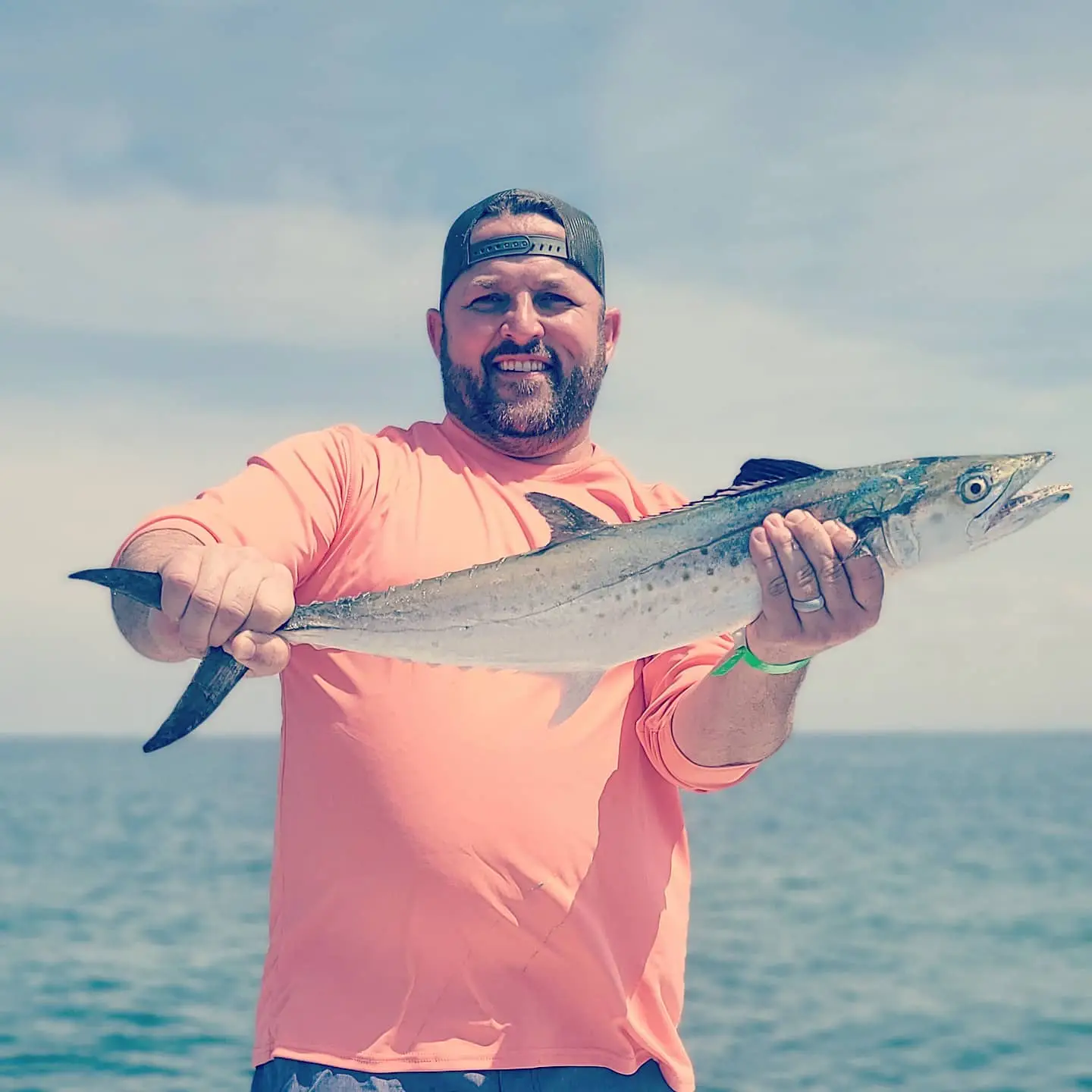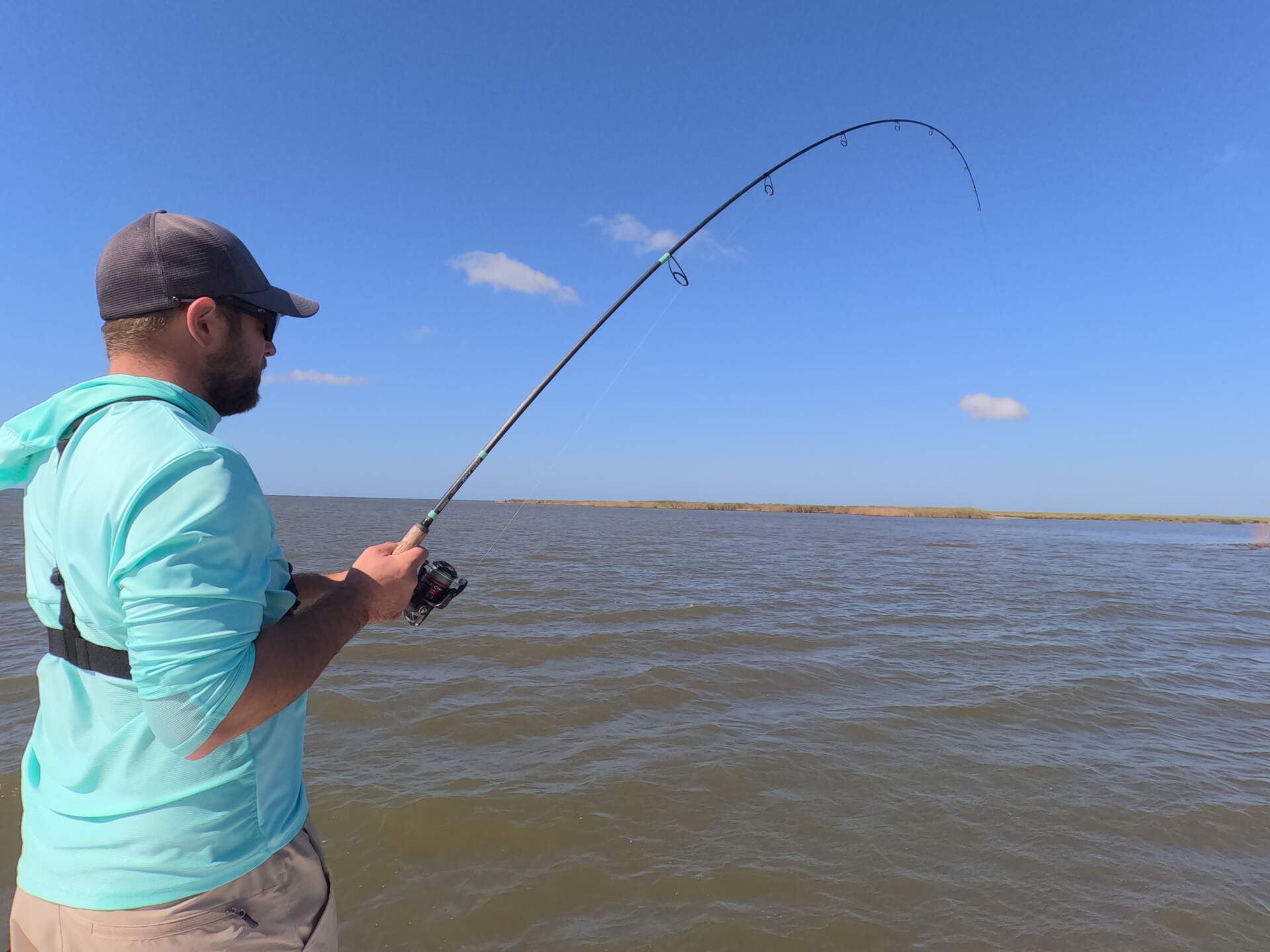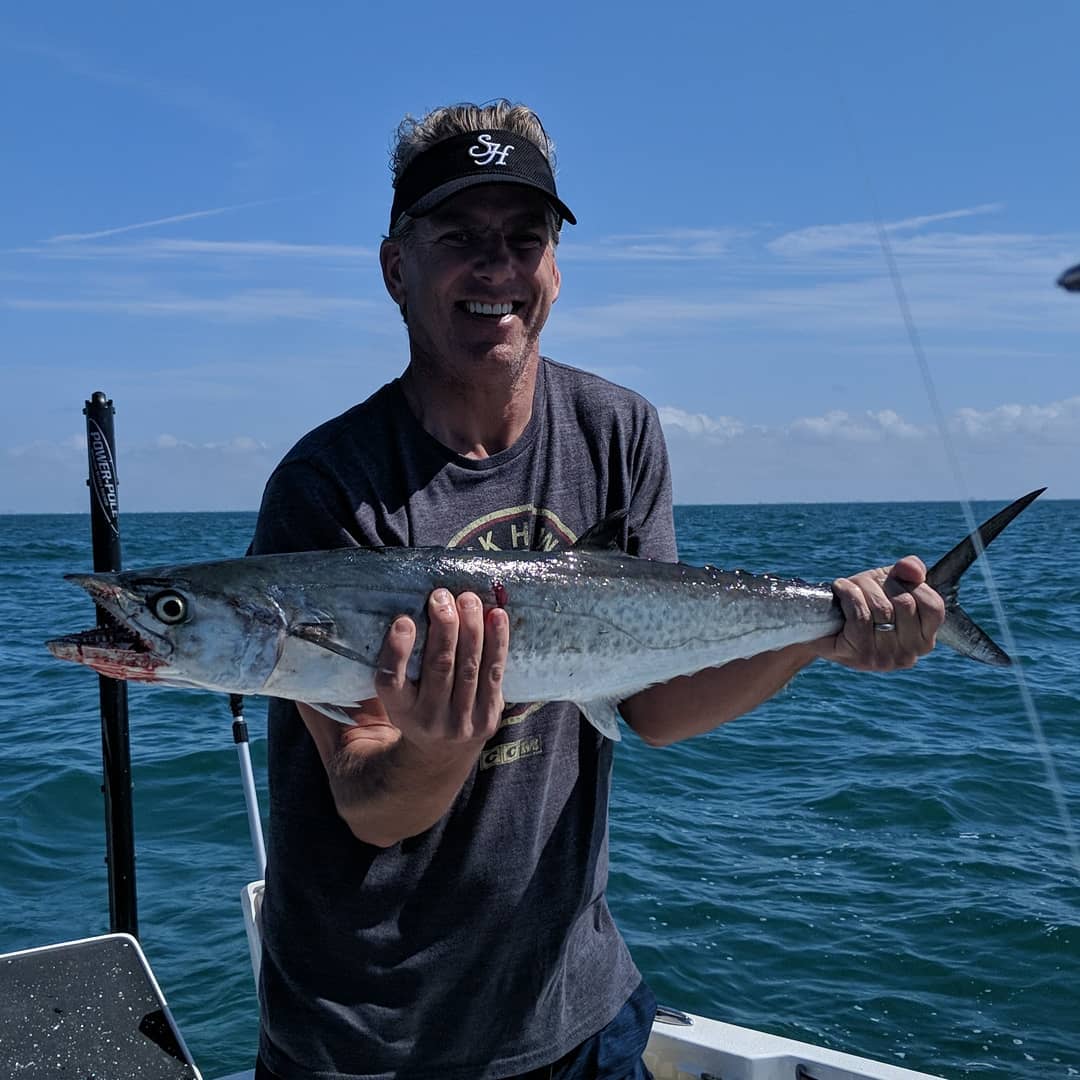King Mackerel, known locally as “Kingfish” or simply “Kings,” are highly prized by fishermen along Louisiana’s coastal waters, especially during the spring season. This guide provides an in-depth look at the King Mackerel species and detailed techniques for successfully catching them in the springtime along the Louisiana coastline.
Detailed Species Description: King Mackerel
King Mackerel (Scomberomorus cavalla) are aggressive, predatory fish well-known for their fierce strikes and energetic fights. They are streamlined, torpedo-shaped fish, built for speed and efficiency when hunting prey. King Mackerel typically exhibit shades of bluish-green on their backs, fading to silver along their sides and bellies. They can be easily identified by their sharp, pointed snouts, large mouths lined with razor-sharp teeth, and distinct lateral line that curves sharply downward near the tail.
Adult King Mackerel commonly weigh between 10 and 30 pounds, though larger specimens—up to 50 pounds or more—are not uncommon, especially during peak migrations in the spring. Their size, speed, and aggressive feeding habits make them particularly desirable for both recreational and tournament anglers.
Seasonal Patterns on the Louisiana Coast
The Louisiana coastline sees significant King Mackerel activity from late March through May, with April typically marking the height of the spring season. As waters begin to warm, large schools of baitfish—particularly menhaden (pogies), threadfin herring, mullet, and Spanish sardines—move into coastal waters, drawing the King Mackerel closer to shore and around offshore structures.
Kings favor water temperatures ranging from 68°F to 78°F, making springtime along the Louisiana coast ideal. During this season, anglers frequently find Kings near structures such as oil platforms, artificial reefs, wrecks, and underwater ridges.

How to Catch Spring King Mackerel in Louisiana
Successfully targeting King Mackerel along Louisiana’s coast during the spring involves understanding their preferred locations, the best methods to present bait, appropriate tackle choices, and ideal fishing techniques.
1. Locating King Mackerel
Kings are attracted to structure because these areas congregate large numbers of baitfish. Ideal fishing spots include:
-
Oil Rigs and Platforms: Louisiana’s many offshore platforms act as natural baitfish magnets. These structures provide ample cover for bait, drawing Kings close by.
-
Artificial Reefs and Shipwrecks: Artificial reefs and wreck sites also attract Kings, providing both food sources and shelter.
-
Nearshore Buoy Lines and Channel Markers: During spring, Kings occasionally venture closer inshore, often within sight of shorelines near marked channels and buoys.
Always pay close attention to bait activity on the surface or near structure. Diving seabirds, baitfish schools visibly leaping from the water, or visible slicks indicate prime areas for targeting Kings.
2. Recommended Gear and Tackle Setup
Proper tackle significantly influences your success with Kings, which are notorious for powerful runs and sharp teeth capable of cutting lines easily. Consider the following setups:
Rods and Reels:
-
Rods: Medium to medium-heavy action rods, ranging from 7 to 7½ feet, rated for 15–30 pound line. Rods should have sufficient backbone for controlling larger Kings but enough flexibility to manage rapid runs.
-
Reels: High-quality conventional or spinning reels designed for saltwater use. Conventional reels such as Shimano Torium or Penn Squall are popular due to their strength and reliability. Spinning reels in the 6000–8000 series size range work well, particularly when targeting smaller to medium-sized Kings nearshore.
Line and Leaders:
-
Main Line: 20–30 lb test monofilament or 40–65 lb braided line. Monofilament has better shock absorption, while braid provides greater line capacity and sensitivity.
-
Leaders: Use a 30–50 lb fluorocarbon or monofilament leader of 4–6 feet attached to a short (12–18 inches) section of wire leader. Wire leaders (No. 4 to No. 7 single-strand wire or 40–60 lb test cable wire) are necessary to avoid losing fish to sharp teeth.
3. Best Baits and Lures for King Mackerel
Choosing appropriate bait is essential. Kings hunt aggressively, so your presentation should reflect their natural prey.
Live Bait:
-
Pogies (Menhaden): Preferred live bait in spring, rigged on stinger rigs (multiple hooks).
-
Threadfin Herring: Excellent bait, hardy, and very active underwater.
-
Live Mullet or Blue Runners: Larger, tougher baits suitable for attracting trophy-sized Kings.
Dead/Natural Bait:
-
Frozen or Fresh-Caught Ribbonfish: Ribbonfish (also called cutlassfish) rigged whole are highly effective, especially for larger Kings.
-
Spanish Sardines and Cigar Minnows: Rigged whole or as chunks, these baits consistently produce results.
Artificial Lures:
-
Trolling Spoons: Silver or gold spoons, typically 3–6 inches in length, attract aggressive strikes.
-
Diving Plugs (e.g., Rapala Magnum, Yo-Zuri Crystal Minnow): Larger plugs imitate fleeing baitfish effectively.
-
Jigs: Heavy, flashy jigs worked vertically around offshore structures can quickly draw Kings into biting.
4. Techniques for Catching Kings
Trolling:
Trolling remains one of the most productive methods for King Mackerel:
-
Speed: Troll at speeds between 3 to 6 knots, adjusting speed according to lure action and sea conditions.
-
Spread: Run multiple rods at varying depths (surface, mid-water, and deep divers) and distances behind your boat. Mix live bait, dead bait, and artificial lures to identify what Kings are hitting best.
-
Depth Control: Use diving planers or downriggers when Kings hold deeper, especially around offshore structures.
Drift Fishing:
Drifting live or natural bait around structure can be highly effective, especially around offshore platforms or wrecks:
-
Position your boat upwind or up-current from structure, allowing your bait to drift naturally through King feeding zones.
-
Keep bait fresh, lively, and at varying depths until you identify where Kings are feeding.
Chumming:
Chumming with chunks of pogies or oily fish is very effective for bringing Kings closer to your boat. This method enhances drift fishing by keeping Kings actively feeding nearby.
5. Handling and Landing King Mackerel
Kings run fast and hard, frequently leaping or making sharp runs that can test your gear. When a fish is hooked:
-
Maintain steady pressure. Avoid excessive drag to prevent line breaks.
-
Use gaffs or large landing nets to safely bring Kings aboard. Their sharp teeth and fast movements require caution when handling.
-
Immediately ice your catch to preserve quality.
6. Safety and Regulations
Always verify the current Louisiana fishing regulations concerning size limits, bag limits, and seasonal closures before fishing. King Mackerel regulations frequently change, making it important to check annually.
-
Typically, Louisiana has a minimum fork-length limit of 24 inches for Kings, with bag limits and specific size regulations that can change by year.
-
Maintain proper licenses and ensure safety equipment meets state guidelines.

Turning Springtime into King Mackerel Success
Fishing for King Mackerel along Louisiana’s coast in spring consistently rewards fishermen who take the time to prepare thoroughly. The techniques outlined in this guide—including selecting productive fishing locations near oil rigs, artificial reefs, wrecks, and buoy lines; choosing effective bait like pogies, ribbonfish, and threadfin herring; and using the right trolling speeds and drifting approaches—are essential for turning a promising day on the water into a reliably successful one. By carefully matching your gear, such as rods suited for handling strong runs and reels that provide reliable drag, you’ll be prepared when Kings strike aggressively.
Putting all these details into action increases your ability to consistently locate and catch King Mackerel during their peak migration along Louisiana’s coastline. When you’re ready to experience this firsthand, book a fishing trip with us at FishnLA. We offer charter trips tailored specifically to fishermen interested in targeting Louisiana’s marshes, exploring productive inshore areas, or heading offshore to fish near rigs and reefs. Our professional captains have deep local knowledge and experience, enabling us to put you right on the spring Kingfish action. Contact us today to schedule your next trip, and experience for yourself the exceptional fishing that Louisiana has to offer.

